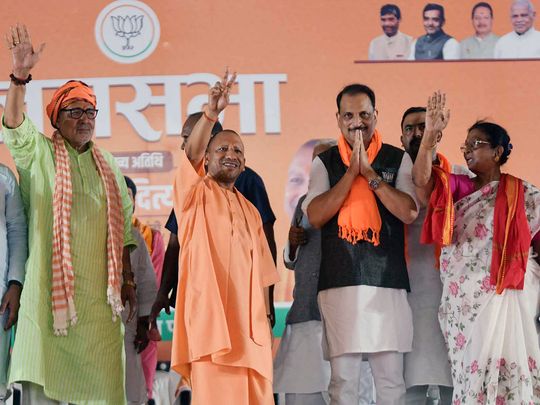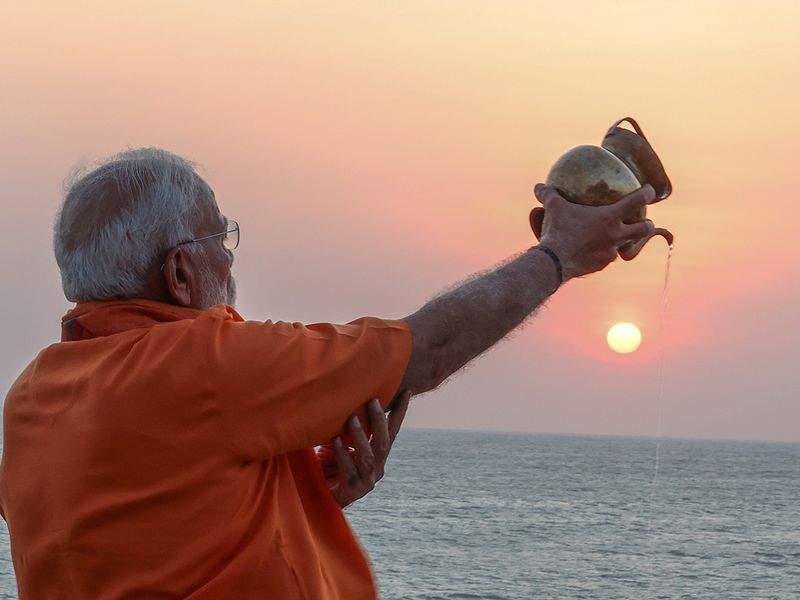
In the outskirts of Allahabad, I meet a group of four women enjoying the shade of a tree. I ask them about politics and elections but they are tight-lipped, refusing to provide any insight into their voting behaviour. A man sleeping on a cot wakes up, and he is more forthcoming.
Hearing the conversation, the women decide to give it away. “We are Telis by caste, same as Modi. Who do you think we’ll vote for?”
Such is the importance of Uttar Pradesh in India’s national landscape that Gujarat chief minister Narendra Modi had to contest from Varanasi to become India’s prime minister in 2014.
Ten years later, what has not changed in UP is the all-consuming popularity of PM Modi. When you ask people who they are voting for, they often say “Modi” and not his Bharatiya Janata Party.
The Modi factor is particularly strong among a large demographic of lower castes, the “non-Yadav OBCs”, who were fragmented before 2014. They used to be too small to be counted, like the Teli women in Allahabad, but now they feel represented. Some also report being liberated from the fear of Yadavs, a dominant OBC community.
The non-Yadav OBCs continue to be with the BJP because of PM Modi, united as a block as they never were.
And yet, something has changed in Uttar Pradesh over 2014 and 2019. The changes may not show a decisive shift in seats yet, but they should reflect in vote-share.
Unhappily voting for BJP
For a rather large number of those voting for BJP, the 2014 honeymoon has turned into an unhappy marriage. Travelling in different parts of the state recently, your columnist found the main reason for the discontent to be the BJP’s choice of candidates.
We’ve heard the complaint in 2019 as well, and even in the assembly elections of 2017 and 2019. But the murmur is becoming a loud noise on the streets. The lack of enthusiasm for the election in general is contrasted by how strongly voters feel against the BJP’s candidates.
Whether you go to Kairana or Phulpur, Kaushambi or Meerut, you hear people say the seat has become “tight” for the BJP. Ask the same people who they are voting for and the answer may be BJP. Why? Modi.

So why has it become “tight”? It’s the candidate, mostly.
It’s as if the BJP has gone out of its way to find unpopular candidates. In Kairana, the sitting BJP candidate has been repeated. He is so unpopular that we met Gujjar voters saying they voted for the Samajwadi Party’s Muslim candidate over the BJP’s Gujjar candidate.
I met Rajput voters who didn’t go to vote because they didn’t want to take “risk”. What risk? “If I had gone to vote I would have voted for BJP. I didn’t want to take that risk,” said one Rajput farmer.
In Sangam, Hindu priests complained repeatedly how local popularity didn’t seem to matter in the BJP. They felt that being a local popular leader was a demerit in the party. They were angry at the BJP for giving the ticket to a late BJP leader’s son who was hardly active in public life until his name was announced.
The resurgence of caste
Modi’s stupendous success in 2014 transcended caste divides. However, there was a lot more discussion of caste in this election than previous ones.
The most prominent of caste talk was Rajput anger, particularly in the first few phases. Rajputs often didn’t go to vote and hardly any may have voted against the BJP.
They are anyway not in as huge numbers as non-Yadav OBCs to cause tectonic shifts. Yet, if the BJP’s core upper caste voter is upset despite having a Rajput chief minister in the state, it tells you how the BJP’s large caste coalition is getting too unwieldy to manage.
In one Rajput village in Kairana, a Rajput family counted a long list of grievances which included Yogi Adityanath not getting due respect from the party’s top leadership. The speculation that the BJP leadership in Delhi wants to remove Yogi Adityanath is now village chatter.
There is resurgence of caste also because of the poor choice of candidates: for some voters we met, the Modi factor wasn’t enough to make them vote for a poor BJP candidate over a good SP/Congress candidate of their own caste. This was tough to find in 2014 and 2019.
But the BJP has increased its popularity in one caste: the Jatavs, Mayawati’s own caste. Many Jatavs are deserting BSP for BJP, citing free ration and other welfare schemes as the reason. The old generation is sticking with the BJP, and some unemployed Jatav youth were voting for the SP/Congress in places.
However, the BJP’s unshakeable hold over Pasis, a key Dalit community, has given way to discontentment. Such changes may appear inconsequential in the larger picture for now, but there is an unmistakable ferment.
Minority consolidation
The BJP won a shocking 71 of 80 seats in Uttar Pradesh in 2014. This was possible partly because the Muslim vote was divided three-way between SP, BSP and Congress. Not only are Muslims 20% of the population, they are concentrated in some regions, giving them the ability to decide the winner. Except when their votes are divided.
But 2024 is a bit like the 2022 UP Vidhan Sabha elections. UP’s minorities are now clear they are not going to waste a single vote on the BSP.
The SP-Congress alliance has helped immensely in this regard this election. Muslim consolidation alone means the BJP’s dream of crossing 70 seats again looks tough.
Unemployed youth
In 2019 if you asked unemployed youth why they were voting for Modi or BJP despite not getting a job, the stock reply taught by the BJP cadres was ready: “Can Rahul Gandhi create jobs?”
In 2024, educated unemployed youth say they are voting against the BJP. These are the youth who prepare for competitive exams, and they are now like a caste group of their own.
They may not be big enough in numbers to defeat the BJP from its big margins, but their disenchantment is one of many reasons why you no longer see the 2014-19 kind of excitement about the BJP on the streets. The opposition may not be able to mobilise them but they are vocal in society nonetheless.
BJP vs anti-incumbency
Unlike earlier elections, the BJP has no one to campaign against. The BJP is unable to position itself as the underdog against Rahul, Akhilesh, Mayawati, “Goonda Raj”, “Appeasement” or any of the old tropes.
It’s now BJP against anti-incumbency. It’s another matter that the opposition is unable to exploit this anti-incumbency to create a “wave” in its favour. The BJP remains the default party.
BJP voters have lost their innocence, but they don’t have a good enough alternative to switch.









